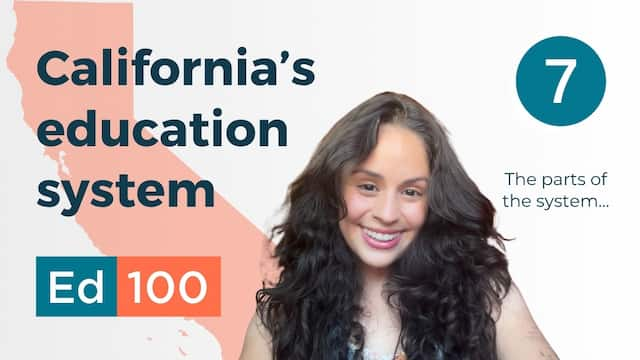
Teachers unions have tremendous influence in America’s public schools, perhaps nowhere more so than in California.
In This Lesson

What do teachers unions do?
What is collective bargaining?
Do all school districts use collective bargaining?
How do teacher contract negotiations work?
Are teachers unions good?
Are teachers unions bad?
What is the education coalition?
How much are teachers union dues?
What do teachers union dues pay for?
Are teachers union dues mandatory? What are paycheck protection laws?
Is teachers union membership decreasing or increasing?
Who leads teacher unions?
How does California's biggest teachers union make decisions?
▶ Watch the video summary
★ Discussion Guide
This lesson describes the major functions of these unions, and summarizes varying points of view about their role in student learning.
There are two main national teachers unions in the USA: the National Education Association (NEA) and the American Federation of Teachers (AFT). Most California K-12 teachers are organized by the California Teachers Association (CTA), which is NEA-affiliated. California’s largest districts are dual-affiliated with both CTA and CFT, the state branch of the AFT. This may seem like detail, but it is an important one: there is more than one teacher union, and they exist at multiple levels: school, local, regional, state, and national. Although teachers unions work hard to align their point of view (which maximizes their power) they are complex organizations that contain many divergent interests.
Teacher contracts are negotiated using collective bargaining
Teacher contracts in California districts are negotiated between the school board (represented at the bargaining table by local district administrators) and the teachers (represented by local union leaders elected by teachers). The negotiation process, called collective bargaining, has been in place since the passage of the Rodda Act in 1975.
In California, virtually every school district uses collective bargaining.
In California, virtually every school district (Clovis is the largest exception as of 2024) uses collective bargaining. Collective bargaining is not used in all US states. Teacher contracts can be complex agreements that address more than pay. In California, many issues related to working conditions are subject to bargaining. (As an example, have a look at the 2017 bargaining blueprint for the union in Oakland.)
Teacher strikes are illegal in most states, but legal in California. Thankfully they have been quite rare, partly due to the work of organizations that exist to mediate disputes. Learn more about the process in the Ed100 blog.
Are teacher unions good or bad?
There is great sound and fury in education reform discussions about whether unions are “good” or “bad” for public education. Most old hands in the education arena (though not all) view this as a false choice.
“Unions are Good”“Unions are Good”
There is no question that states with strong unions, such as California, tend to pay teachers more than those with weaker unions. Teachers in strong-union states also generally have more generous health care benefits. For the big picture of how teacher pay in California has compared to other states over time, see the graph in Ed100 Lesson 3.1.
Supporters of teachers unions also argue they ward off state micromanagement of the classroom. CTA lobbyists generally oppose bills that create hard and fast rules about what teachers can or cannot do. Usually they favor policies that place authority at the local level where districts and unions can work them out through collective bargaining. Among influential thinkers who support teacher unions, perhaps the most prolific and well-known is Diane Ravitch.
“Unions are Bad”“Unions are Bad”
Among critics of unionism in education, the writings of Terry Moe remain influential. His essential argument is that unions’ interests are poorly aligned with those of students and taxpayers. Notably, Moe framed the argument that negotiations between districts and unions are structurally out of balance. The union’s power to call a strike is unmatched by any equivalent power from the district side. Districts cannot lawfully dismiss striking teachers and hire replacements. Critics also note that unions make unapologetic use of the democratic process to influence the other side of the bargaining table by using their resources to support or oppose candidates for school boards.
For decades, Mike Antonucci reported on teacher unions in California. Currently active critics, such as Nathan Benefield, tend to focus their energy on school choice policies.
At the state level, critics object to teacher unions’ capacity to raise funds for political action. As of 2024, a typical full-time teacher in a CTA-affiliated district pays more than $1,000 in union membership dues annually. Of this amount, about 15% goes to the NEA, about 20% goes to the local affiliate, and the remainder goes to the CTA state organization. A portion of these resources supports the unions’ political efforts, which can have decisive influence especially in local elections. School districts are not allowed to spend public money on political campaigns.
Teachers unions provide expertise
School district finances and contracts are complex. Both local unions and school districts rely on state organizations for technical support.
The staff of the CTA and CFT provide negotiating support to their local affiliates. School districts hire consultants such as School Services of California. If you want to see what the contracts actually look like, check the National Council on Teacher Quality. It has posted copies of collective bargaining agreements for America’s 140 largest districts, and provides an orderly database to research the major provisions of these agreements.
What is the Education Coalition?
Both CTA and CFT are members of California's "Education Coalition," a group of education-related advocacy organizations. This coalition lobbies for education spending in the annual zero-sum budget battle with other budget priorities from prisons to health care to transportation. This is important work, particularly in California, which spends proportionally fewer tax dollars on education than most states do.
Why are teachers unions so powerful?
Each teacher contributes about $1,000 per year
Teachers unions are among the most powerful organizations in American public life. How did that happen?
Part of the answer is money. For decades, teachers in many states' public schools were required to pay union fees. The logic behind this requirement was that since their economic interests were being collectively represented at the negotiating table, they had to pay their fair share. After decades of fierce debate, in 2018 the US Supreme Court eliminated this obligation. It ruled in the Janus decision that union fees are a form of speech protected by the First Amendment, and that mandatory "fair share" fees for representation in collective bargaining are an unconstitutional form of compelled speech. This was a major reversal with big implications for the education system.
A little background is in order.
In 1977 the US Supreme Court had ruled unanimously in the case Abood v. Detroit Board of Education that unions could collect mandatory fees from employees, including those that opted out of membership in the union. In the years that followed, about half of American states, including California, passed laws that allowed collective bargaining agreements to include "agency shop" agreements. Under these agreements, all employees paid "agency fees" or "fair share" fees, even if they declined to join the union as members.
Teachers cannot be required to pay union fees.
Not all states supported the "agency shop" approach allowed by Abood. Some states passed "paycheck protection" measures, requiring that unions gather an "opt in" commitment from each member in order to collect certain dues or fees from them. In 2015 the US Supreme Court took up review of the matter in the Friedrichs case. With one open seat on the court, it split 4-4. The issue was taken up again in the 2018 Janus decision, which reversed Abood in a bitterly divided 5-4 ruling. In effect, the Janus decision means that teachers cannot be required to pay fees related to their representation.
In their deliberations, justices on the Supreme Court expressed concern about the disruption of "labor peace". If dues are not collected from all teachers, some labor historians argued ominously, a functioning system might be disrupted. To unify their members, public labor union leaders might find themselves under pressure to become more militant in negotiations. Union opponents countered that the evidence of militancy is thin in states with "right to work" laws.
Union membership rates: Decreasing, but higher in California
Over decades, union membership in America has declined somewhat, including in California.
Generally, union membership rates tend to be higher in California than in other states, partly because of the strength and organization of the state's teachers unions. After the Janus ruling, some predicted that masses of teachers would stop contributing to their unions. That mostly didn't happen. In California, membership has drifted slowly downward over time, but mostly among new teachers. The process to revoke membership is intimidating but clear.
Teachers unions as agents for change
Teachers unions aren’t going anywhere, and they have tremendous power. Money is certainly part of their power, but the power of their membership is even greater. Teachers voices are trusted in every community.
Teachers unions are stable
The leadership of teachers unions tends to be stable over time, with a strong tradition of seniority. Administrators may come and go. School board members have limited terms. Teachers, by contrast, work in a system that directly discourages moving. When teachers stay with a district, they gain seniority and move up the pay scale. The individuals involved in union leadership generally stay involved for many years. If you want to know about the history of your district, ask the local union leaders.
With more than 300,000 members, CTA grapples with the operational challenges of any large organization. Its governing body is the 731-member State Council, a regionally-elected body that meets quarterly.
Nimbleness is out of the question.
There are only a few conference halls in California large enough to host a CTA state council meeting in real life. Like Congress (for perspective, a policymaking body about half its size), the State Council uses a highly structured deliberative process that includes standing committees, speechmaking, and internal politics. Decisions are ultimately brought to the full body of delegates for a vote. CTA staff and executive leadership are guided in their actions by a massive policy manual that the organization takes quite seriously.
The long experience and steady perspective of union leadership creates an opportunity for teacher unions to play a strong role in education change, when a consensus for change can emerge. Many points of view exist within the organization, and it can take quite a while for ideas to bubble to the surface in the form of policy changes. Changes to CTA policy must go through the State Council, a process that takes time. The Teacher Union Reform Network (TURN) is an informal national organization that union leaders have used off and on to discuss ideas for change.
Updated November 2024
CHAPTER 7:
And a System…
-
And a System…
Overview of Chapter 7 -
The Role of State Government in Education
California’s Constitutional Responsibility -
The Federal Government and Education
Small money, Big Influence -
School Districts in California
What do School Districts Do? -
County Offices of Education
Oversight and Regional Services -
Teachers' Unions in California
What do Teacher Unions Do? -
Ballot Initiatives and Education
California's Initiative Process and How It Affects Schools -
Who Influences Education?
Politics, Philanthropy and Policy -
Accountability in Education
Who Monitors the Quality of Schools? -
What to Do with Failing Schools
Interventions and Consequences in California -
The LCAP
Annual Plans for California School Districts
Related
Sharing is caring!
Password Reset
Search all lesson and blog content here.
Login with Email
We will send your Login Link to your email
address. Click on the link and you will be
logged into Ed100. No more passwords to
remember!
















Questions & Comments
To comment or reply, please sign in .
Jeff Camp February 6, 2020 at 1:49 pm
Jamie Kiffel-Alcheh November 23, 2019 at 11:36 am
Susannah Baxendale February 17, 2019 at 3:00 pm
Susannah Baxendale February 17, 2019 at 2:57 pm
Jamie Kiffel-Alcheh November 23, 2019 at 11:38 am
Jeff Camp - Founder April 5, 2017 at 3:27 pm
Jeff Camp - Founder March 30, 2016 at 10:24 am
Jeff Camp - Founder October 23, 2015 at 9:30 am
Carol Kocivar - Ed100 December 2, 2014 at 12:33 pm
https://edpolicy.stanford.edu/projects/1266